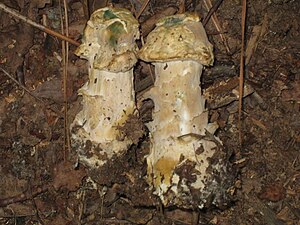Hypomyces hyalinus
| Hypomyces hyalinus | ||||||||||||
|---|---|---|---|---|---|---|---|---|---|---|---|---|

Hypomyces hyalinus |
||||||||||||
| Systematics | ||||||||||||
|
||||||||||||
| Scientific name | ||||||||||||
| Hypomyces hyalinus | ||||||||||||
| ( Pig. ) Tul. & C.Tul. (1860) |
Hypomyces hyalinus is a parasitic hose fungus from the family of the crust ball fungus relatives . It infects fungi of the genus Amanita .
features
Minor crop form
Although the anamorphs have been observed in some samples of H. hyalinus , there is no consistently identifiable link between the fungus and its anamorphs.
Main fruit form
The teleomorph of H. hyalinus is observable and can be identified. A hyphae , the so-called subiculum, covers the host's fruiting body and leads to the destruction of the lamellae and the impossibility for the host to spread its hat. The subiculum is white, with age also pale or with a pink, yellow or brown tone and completely surrounds the host. It doesn't react with KOH . The actual fruiting bodies , the perithecia , are egg-shaped to pear-shaped. They grow to be 250-325 × 180-210 micrometers in size, are pale to light orange or brownish and colorless in KOH. They are embedded in the subiculum, only their tip (papilla) protrudes. The spores are spindle-shaped, almost boat-shaped to lanceolate. They are finely pointed and clearly warty. They measure 15–20 × 4.5–6.5 micrometers and are two-celled with a septum near the base.
distribution
Hypomyces hyalinus has a large distribution area. Evidence has been obtained in eastern Canada , the north and southeast of the United States, and China and east Asia . The earliest record of the parasite is from Salem, North Carolina , in 1822 , but microscopic descriptions of H. hyalinus did not appear in the literature until 1886.
ecology
Hosts
H. hyalinus is a host-specific pathogen that only infects species in the Amanita genus , which groups together some of the most poisonous fungi in the world, including the pearl mushroom ( Amanita rubescens ) and the fly agaric ( Amanita muscaria ). H. hyalinus particularly attacks the basidiocarp of the host's fruiting bodies .
Effects
Hypomyces hyalinus destroys the exterior of its hosts so completely that in the absence of a healthy specimen in the vicinity, it is not possible to determine the host in the field. The infection often covers the host and prevents the hat from spreading , causing it to become deformed and fuse with the stem . As a result, the lamellae of the fungus are also destroyed and the fruiting body dies without having spread spores .
Life cycle
The life cycle of Hypomyces hyalinus is currently not fully understood. Generally it goes into the department Ascomycota between an asexual and a sexual phase, which also anamorphic or Teleomorphs hot. Each of these phases includes intermediate steps that vary depending on the species.
research
Completed
H. hyalinus has been studied in many ways. Field studies were used to monitor the effects on the hosts.
In addition to direct field observations, the fungus was cultivated on oatmeal agar and potato dextrose agar to enable biochemical and microscopic investigations. A KOH string test , which checks the gram status of an organism, resulted in H. hyalinus being classified as gram-positive . In addition, different microscopy methods have been used to observe the fungus, such as brightfield , fluorescence , differential interference contrast and phase contrast microscopy .
Continuing
There is little evidence in the scientific literature on Hypomyces hyalinus . Further research would be helpful to e.g. B. to clarify the life cycle of the species, which would also lead to an understanding of the way in which the pathogen is transmitted. In addition, further research could help manipulate the poisonous fungi of the genus Amanita , as H. hyalinus has a high host specificity.
Although H. hyalinus does not currently have a high economic or social impact, further research could make the parasite useful for society because of its relationship to the (edible and poisonous) species of the genus Amanita . Further research could also clarify the role of H. hyalinus in population, environmental and evolutionary biology issues.
Individual evidence
- ↑ Hypomyces hyalinus (Pig.) Tul. & C.Tul. . In: GBIF Taxonomy Backbone . Global Biodiversity Information Facility .
- ↑ a b c d e f g D. F. Farr, AY Rossman: Hypomyces hyalinus (Schwein.: Fr.) Tul. 1860 (Ascomycetes, Hypocreales) . In: Fungal Databases . US National Fungus Collections, ARS, USDA. Retrieved August 27, 2019.
- ↑ a b c d e f g h i j k Clark T. Rogerson, Gary J. Samuels: Agaricicolous Species of Hypomyces . In: Mycologia . 86, No. 6, 1994, pp. 839-866. doi : 10.1080 / 00275514.1994.12026489 .
- ↑ Lewis David von Schweinitz: Synopsis fungorum Carolinae superioris secundum observationes . In: Writings of the Natural Research Society in Leipzig . September 1, pp. 20-131.
- ^ JB Ellis, BM Everhart: Synopsis of the North American Hypocreaceae, with Descriptions of the Species . In: The Journal of Mycology . 2, No. 3, 1886, pp. 28-31. doi : 10.2307 / 3752784 .
- ^ Scott Sutton: The Gram Stain . In: The Microbiology Network (Ed.): PMF Newsletter . February 2006.
- ↑ Arthur Westmann: BACTERIA IDENTIFICATION BY KOH STRING TEST . August 22, 2018. Retrieved August 27, 2019.
- ^ T. Wieland: Poisonous Principles of the Genus Amanita . In: Science . 159, 1968, pp. 946-952.
Web links
- Record details . In: Index fungorum . Retrieved on August 27, 2019: "As Sphaeria hyalina pig."